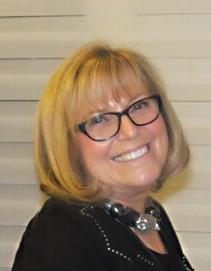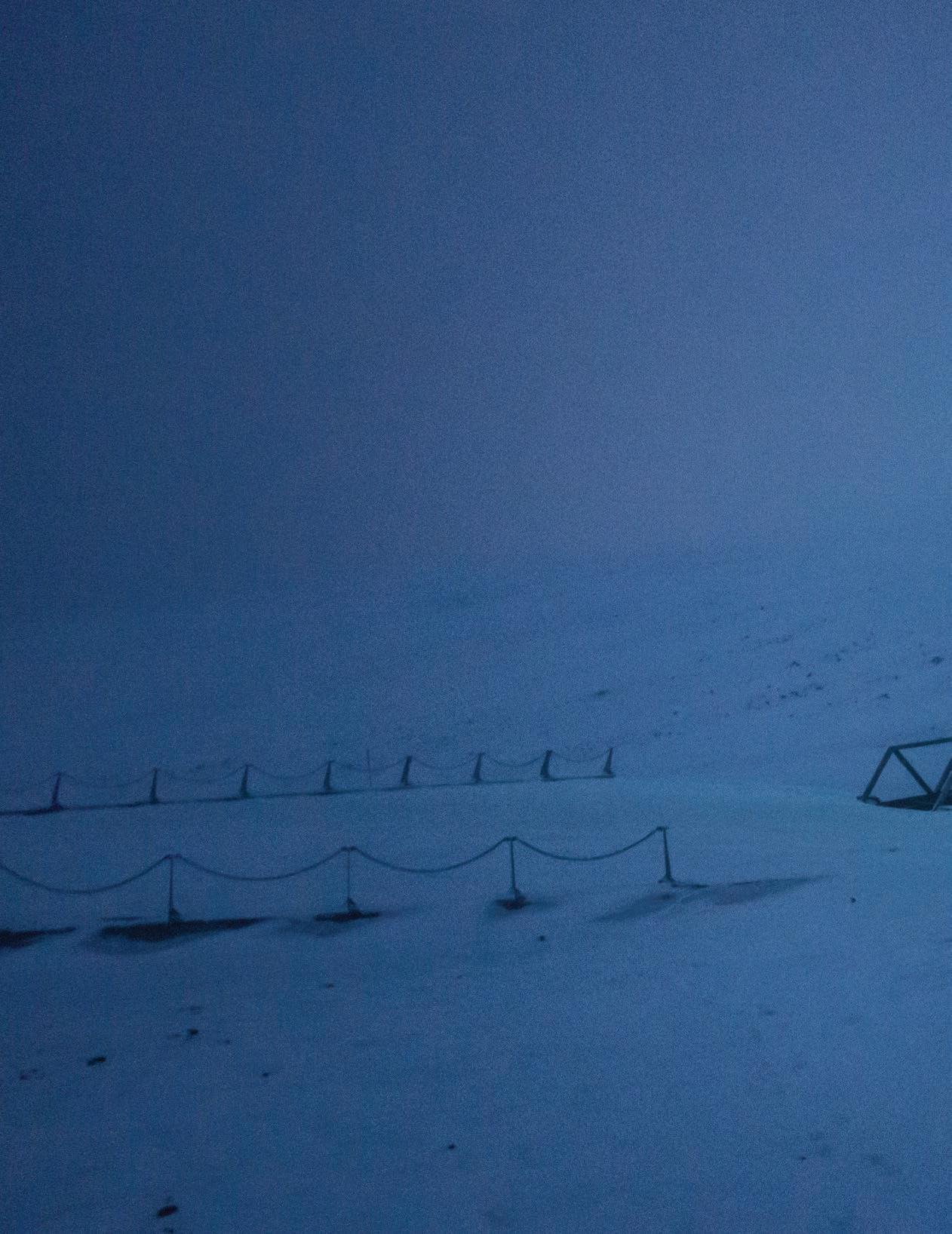
14 minute read
Seed conservation: How the world prepares for the worst
Preparing for disaster
Saving the world’s seeds has become an even more important endeavour than it had been before COVID-19.
Advertisement
By Laura Neilson Bonikowsky
Humans are fearful. We grapple with our mortality, unable to imagine the planet without us, but optimistic that we will prevail. Our anxiety has been reflected in popular culture for eons, from the Epic of Gilgamesh, circa 2000 BC, to The Walking Dead. Our fears rise as the century wanes and the new one begins. We see multiple zeroes in a date as preternatural, convinced it portends disaster, and we react emotionally. In these early decades of the 21st Century, we are ripe for heightened fears and anticipate apocalypse through climate change or a virus (including the zombie variety.)
We feel the need to prepare; in all scenarios, survivors must eat, a need to be served by the roughly 1,740 vaults and initiatives preserving seeds worldwide. They are insurance against drought, floods, food insecurity, species extinction, war, lost agricultural diversity, climate change and even a zombie apocalypse.

On an island 1,300 kilometres from the North Pole is Norway’s Svalbard Global Seed Vault. It stores nearly one million seed samples — everything from apples and tomatoes to forage grasses and orchids, essentially a back-up copy of the world’s plants.
SEED STORAGE
People have stored seeds for millenniums, stashing them in silos, cellars, barrels and urns for the next planting season or the one after that. We’ve even tucked them in with the dead on their journey to whatever comes next.
Although the world has approximately 400,000 plant species, just 15 provide 90 per cent of the world’s food energy intake, with three — rice, maize and wheat — making up two-thirds of this. The others include potatoes, beans, sorghum, millet, soybean, sugar, yam, rye, barley, oats, teff and cassava.
Saving seeds is both prescient and necessary. Seed vaults, also called gene banks, vary in structure and technology. The shelf life of seeds varies by species; longterm viability requires the right balance of humidity and sub-zero temperatures. But in situ (in the original place) storage preserves the evolutionary processes that allow adaptation.
Gene banks work with farmers and researchers to determine whether crops will grow in different regions — important research given the many threats to agriculture. The world’s regions defined by the United Nations Statistics Division are: Africa, Americas, Asia, Europe and Oceania. Although these regions are vast, their commonalities are important: soil, climate, growing season, agricultural practices, pests and social and political conditions affecting agriculture.
The seed vaults and initiatives presented are organized by geography; they are rated as significant by the U.S. Department of Agriculture (USDA), the Science and Environmental Health Network, CropTrust and Food Tank.
GLOBAL
Slow Food International, a global consortium in Bra, Italy, founded in the mid1980s, has more than 100,000 members in 150 countries. The organization believes we are duty-bound to protect and preserve seeds to guarantee crop biodiversity, which includes promoting diversity. For example, of the thousands of types of apples in the world, how many have you tasted?
UNESCO’s Man and the Biosphere (MAB) reserves (701 in 124 countries) and Global Geoparks are hubs for seed preservation in arid ecosystems. MAB establishes plant nurseries, distributes seedlings and promotes sustainable development. The core of each biosphere is a protected ecosystem that conserves plant species and genetic variation.
AFRICA
The ECHO Global Seed Bank is part of the ECHO community and a resource for development workers experimenting with underutilized crops to support small-scale farmers and gardeners. It maintains a collection of seeds that thrive in tropical and sub-tropical conditions. ECHO in East Africa provides packaged seeds and seed exchanges and in West Africa, training in agricultural practices.
Ethiopia
The Plant Genetic Resources Centre, established in 1976 to conserve Ethiopia’s biodiversity and indigenous knowledge, became the Ethiopian Biodiversity Institute in Addis Ababa. It comprises a series of cryogenic vaults, storing seeds of more than 165 agricultural plant species as well as in situ and ex situ gene banks for endangered forest, medicinal and forage and pasture plants.
Nigeria
The genetic resources of the International Institute for Tropical Agriculture in Ibadan are instrumental in conserving seed crop germplasm to ensure the genetic continuity of crop species and maintain a genetic base for improving them. The institute’s germplasm collection includes peas, beans, soybeans and legumes. Seeds are stored for the medium term at 5C and long-term at -20C.
NORTH AMERICA
Canada
The Canadian Plant Germplasm System is a network of centres for preserving
Norway's Svalbard Global Seed Vault is built into the mountain. It holds 6,377 species but its capacity is 4.5 million seed varieties.


The most successful and widely cultivated cranberries and other crops are the direct result of years of careful breeding. They're grown primarily in Canada and a few states in the U.S.

France's National Research Institute for Agriculture, Food and Environment is studying barley lines at Tessaout Station in Morocco as part of ICARDA's DIIVA project.

A farmer in Morocco examines his onions in the field as part of the International Centre for Agricultural Research in the Dry Areas' ongoing work in Morocco.
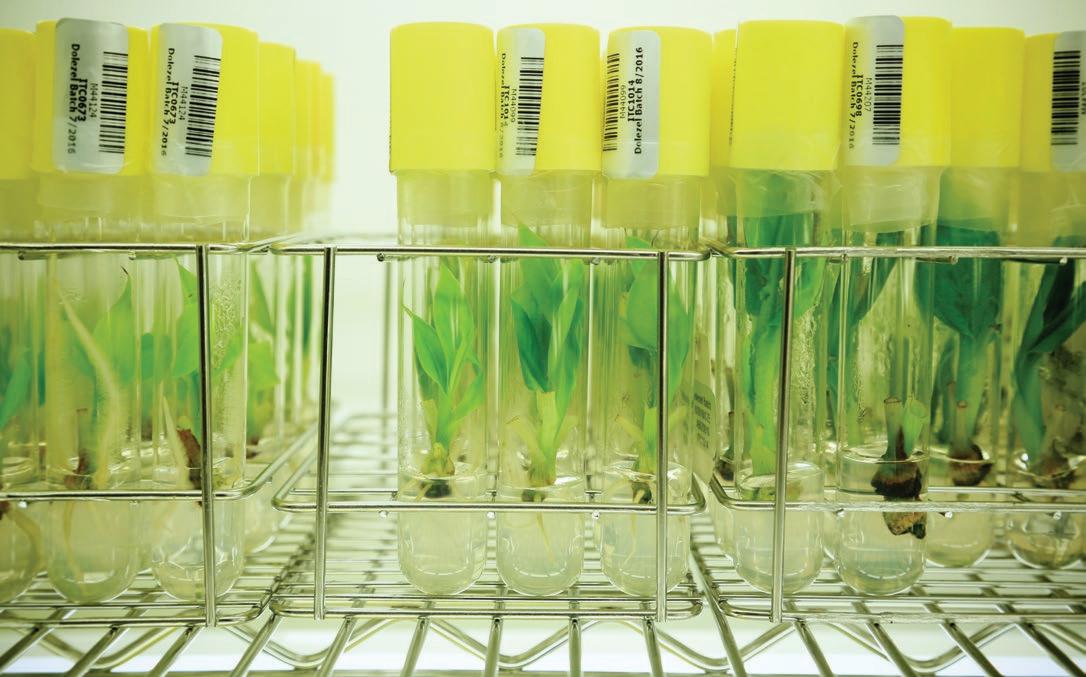
Just 15 crop plants provide 90 per cent of the world's food energy intake, with three — rice, maize and wheat — making up two-thirds of this.
Canadian biodiversity in crop plants and their wild relatives. Plant Gene Resources of Canada was part of Ottawa’s Central Experimental Farm from 1970 until 1998 when it moved to the more modern Saskatoon Research Centre, which co-ordinates Canada’s germplasm system. The gene bank holds 113,000 seed samples. Storage facilities include long-term storage at -20C, medium-term at 4C and 20 per cent relative humidity, and cryopreservation units, which involve freezing in or over liquid nitrogen at -196C. Other centres are the Fredericton Research Centre in New Brunswick, responsible for potato varieties, the Canadian Clonal Genebank in Harrow, Ont., for fruit trees and smallfruit crops and the Canadian Animal Genetic Resources Program for cryopreservation of animal breeds.
United States
Many of the USDA’s facilities include gene banks to preserve major crop genetic resources, such as potato germplasm (Bamberg Lab, Madison, Wisconsin), tree fruits and nuts (National Clonal Germplasm Repository, Corvallis, Oregon) and wheat (Cereal Crops Research Unit, Fargo, North Dakota).
The Agricultural Genetic Resources Preservation Research facility in Fort Collins, Colorado, protects more than 500,000 accessions (a group of related plant material from a single species collected from a specific location) from almost 12,000 plant species in its cold storage vault, including cryogenically preserved shoot tips that ensure the diversity of clonally propagated fruit species. The unit’s genetic resources include animal, insect and microbial material.
In Griffin, Georgia, the Plant Genetic Resources Conservation Unit holds more than 100,000 seed and plant samples of 1,608 species. The unit’s mission includes preserving genetic resources for agronomic and horticultural crops for researchers and educators.
The Hawaii Public Seed Initiative, founded by the Kohala Centre in Kamuela (Waimea), on the Big Island, Hawaii, works to promote, increase and improve the state’s crop biodiversity. It collaborates with communities, farmers and gardeners to store, improve and exchange seed varieties within the island’s diverse microclimates.
Based in Tucson, Arizona, the Native Seeds/SEARCH conserves seeds of the Southwest U.S. and Northwest Mexico. A leader in heirloom conservation, its stateof-the-art facility houses roughly 2,000 types of seeds adapted to arid land from southern Colorado to central Mexico. Seed varieties include corn, beans and squash traditionally used by the Apache, Hopi, Mayo and other tribes.
SOUTH AMERICA
Colombia
The International Center for Tropical Agriculture, though based in Cali, Colombia, works in Africa, Asia, Latin America and the Caribbean. It is a CGIAR (Consultative Group for International Agricultural Research) centre that contributes to several UN Sustainable Development Goals related to ecosystems, climate-smart agriculture and sustainable food systems. Its gene bank focuses on beans, cassava and tropical forages.
Peru
Camino Verde Living Seed Bank is a nonprofit organization based in Concord, Massachusetts, operating in the Peruvian Amazon through Puerto Maldonado. Its focus is preserving trees useful for

The Svalbard Vault opened in 2008, though discussions about a storage facility for seed samples from around the world began in the 1980s.
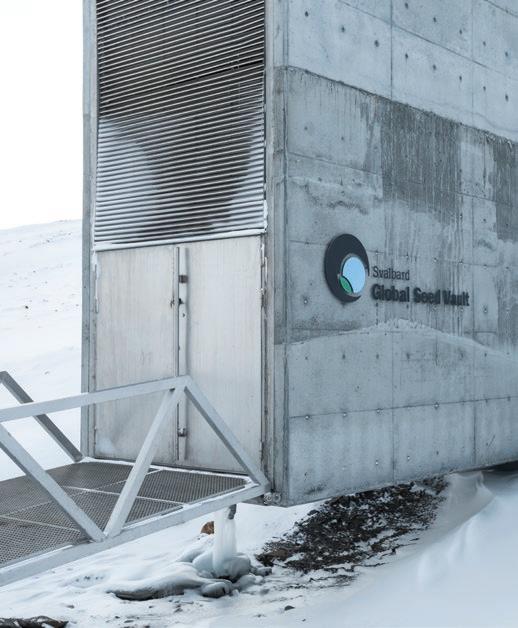

BECOME YOUR OWN SEED VAULT
Saving seeds is simple. Let your plants go to seed (or fruit over-ripen), collect the seeds, let them dry, and store them in airtight, labelled containers (pill bottles, envelopes in a jar) in a cool, dry, dark place. Here are some tips:
Fertile or infertile? Soak seeds from inside the vegetable (tomatoes, cucumbers) in water until they start to ferment (approximately two days). Infertile seeds float; fertile seeds sink. For other seeds, do not soak, but ensure they are dry.
Self-pollinating or cross-pollinating? Self-pollinating plants, such as lettuce, beans, peas, tomatoes and peppers, produce flowers with male and female parts and pollinate within the flower. These seeds stay “true” — they will produce the original species — and are your best bet. Cross-pollinating plants, such as squash, cucumber, cabbage, spinach and broccoli, need pollen to be carried by wind or insects from one flower to another on the same or another plant. If you grow several types and they flower together, cross-pollinated seeds will produce a hybrid that is neither parent plant. To avoid hybrids, grow cross-pollinating plants in alternate years or stagger planting so they will flower at different times if your growing season is long enough.
Viable lifespan? Lifespans are limited without specialized storage, as in a seed repository. The chart below is a general guide.
One year
Carrots
Onions
Peas
Parsnips
Two years
Corn
Peppers
Leeks
Chives
Cilantro
Okra
Three years
Beans
Beets
Chard
Radishes
Spinach
Tomatoes
Broccoli
Carrots
Fennel

Four years
Cabbage
Cauliflower
Eggplant
Lettuce
Melons
Pumpkin
Squash
Kale
Oregano
Five years
Cucumbers
Turnips
Endive
Radishes
Cress
Basil medicine, food and crafts by planting and protecting them to promote genetic diversity from which healthy seeds can be harvested. Camino Verde has planted more than 250 tree species.
ASIA
AVRDC — the World Vegetable Centre — is an independent organization headquartered in Shanhua, Taiwan, with sites in Asia, Africa, Uzbekistan, Korea and Cameroon. Its goals include reducing poverty and improving nutrition through extensive research, which includes collecting, conserving and distributing vegetable germplasms. The centre maintains a collection of more than 61,000 accessions from 155 countries, with approximately 12,000 accessions of indigenous vegetables.
As part of the ECHOcommunity, the ECHO Asia Seed Bank is a resource for de

Show here are pigeon peas from the gene bank in India.
velopment workers within Asia working with underutilized crops. The seed bank maintains a collection of seeds of uncommon plants that thrive in the tropics and sub-tropics.
India
Navdanya means “nine seeds” in Hindi. It is a female-led research-based initiative founded by environmentalist and scientist Vandana Shiva. The network of seed keepers and organic producers has established more than 100 community seed banks across India. It has trained thousands of farmers in sustainable agriculture over
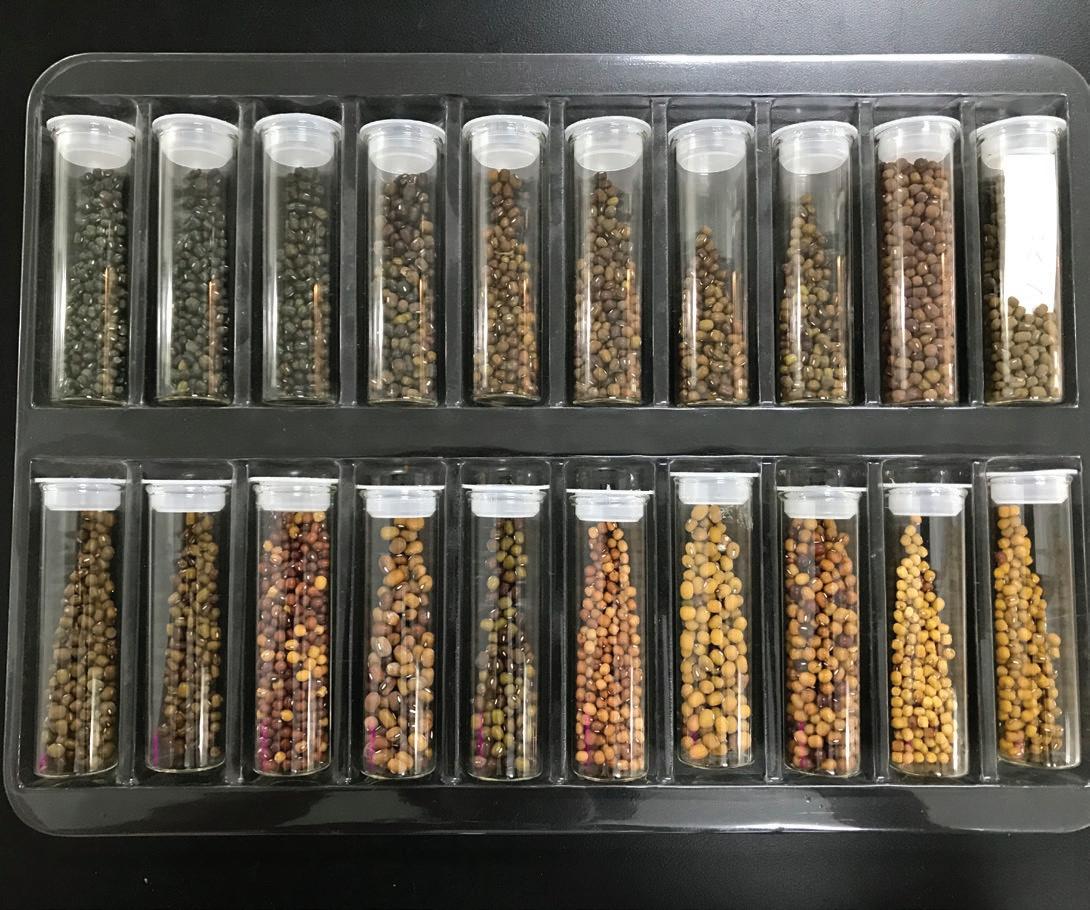
These seeds belong to AVRDC, the World Vegetable Centre, which is an independent organization headquartered in Shanhua, Taiwan, with sites in Asia, Africa, Uzbekistan, Korea and Cameroon.
three decades. Navdanya’s seed bank at its biodiversity farm in Uttarakhand, North India, preserves rice and grains, medicinal plants, amaranth and mustard.
Lebanon and Syria
The International Centre for Agricultural Research in the Dry Areas (ICARDA) is a CGIAR Research Centre headquartered in Lebanon. It conducts research-fordevelopment for communities across the non-tropical dry area, from Morocco to India. ICARDA’s seed bank in Aleppo, Syria, holds more than 130,000 accessions, roughly two-thirds from crops adapted to arid environments. In 2012, as the Syrian conflict raged around them, a group of scientists, concerned that military action would damage their freezers, packaged samples of 87 per cent of their holdings and shipped them to the Arctic.
EUROPE
Norway
Jutting out of a snowy mountain on an island 1,300 kilometres from the North Pole is Norway’s Svalbard Global Seed Vault. It stores nearly one million seed samples — everything from apples and tomatoes to forage grasses and orchids, essentially a back-up copy of the world’s plants. It holds 6,377 species, but its capacity is 4.5 million seed varieties. The vault opened in 2008, though discussions about a storage facility for seed samples from around the world began in the 1980s. There had been a seed facility in abandoned coal mines near Longyearbyen, which has led to the misunderstanding that the Svalbard vault is in a coal mine. It is not; it was carved out of the solid rock of a permafrost mountain where the temperature remains between -3C and -4C. Though funded by the Norwegian government, the vault is not political; it holds seeds from 87 depositors, friend or foe, who retain ownership of their seeds. In 2015, ICARDA became the first organization to make a withdrawal from Svalbard to restore its collection. They replaced the seeds in 2017.
United Kingdom
In the appropriately bucolic setting of the 2-square-kilometre woodland at Wakehurst Place, West Sussex, the Millennium Seed Bank houses contributions from
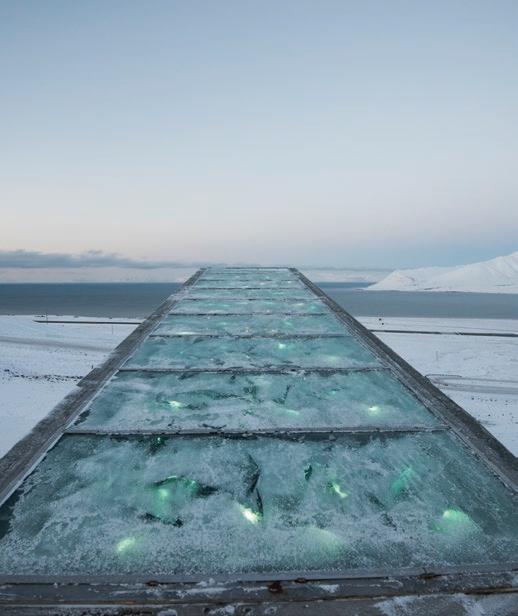
The architectural features of the Svalbard Seed Vault and the landscape make it a playground for photographers.
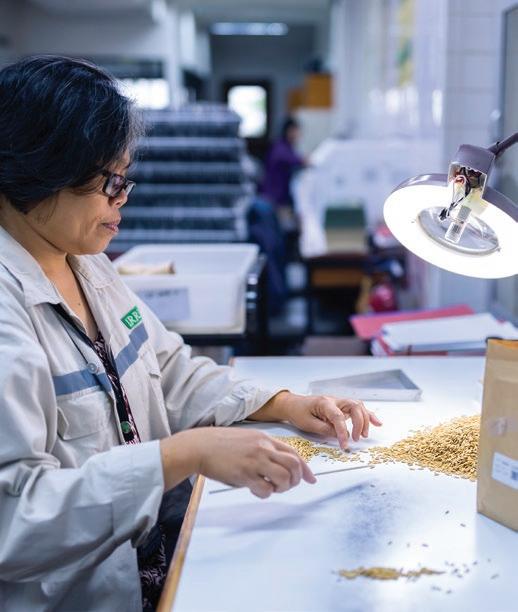
Workers conduct quality control tests over specially produced rice for archiving and distribution at the Philippines-based International Rice Research Institute.
more than 95 countries, including 34,000 wild plant species. Seeds are stored in underground vaults at -20C. It is under the auspices of the Royal Botanic Gardens and housed in the Wellcome Trust Millennium Building. The bank opened in 2000 and in 2009 achieved its goal of obtaining seeds from all of the U.K.’s native plant species, except for a few that are very rare or especially difficult to store.
Russia
The oldest seed bank in the world, founded in 1921, is the Vavilov All-Russian Institute of Plant Genetic Resources (VIR) in St. Petersburg. It was named for agronomist and geneticist Nikolai Vavilov, among the first scientists to understand the need for crop diversity. The VIR has a storied history of politics, war and courage. During the siege of Leningrad in the Second World War, while Soviet officials protected art and heritage, the curated collection of 187,000 seed types was forgotten. Scientists managed to smuggle samples to the Urals, while many stayed with the collection. Nine lost their lives protecting their work, starving to death amid thousands of rice packets. By the 1990s, the gene bank had 250,000 seed types from 50 countries and now has 380,000. In 2010, the institute was threatened with demolition to allow a government-supported housing development, but public outcry delayed the project; it remains vulnerable.
OCEANIA
Australia
Overlooking the Cumberland Plain Woodland, an endangered ecosystem in New South Wales, the Australian PlantBank (formerly NSW Seedbank) works in partnership with the Millennium Seed Bank. PlantBank’s seed vault holds more than 11,000 seed collections plus 723 tissue culture collections, mainly from New South Wales. It uses cryopreservation as well as tissue cultures for plants that don’t produce seeds or whose seeds cannot be dried.
SEED STORES THREATENED
There are many risks to the seeds we’re saving; plant species evolve, pests and diseases adapt, climate change poses unknown challenges. Seed storage means accounting for these risks and avoiding threats to the seed banks themselves.
The Svalbard vault has natural security, being on a rugged, isolated island 120 metres above sea level, without risk from earthquakes or volcanoes. However, in 2017, permafrost around the vault melted and water seeped into the tunnel leading to the vault. The permafrost hasn’t returned, so the Norwegian government is upgrading the vault entrance.
One purpose of seed banks is to ensure the restoration of agriculture if arable land is damaged. Land is being lost to flooding, drought, erosion, pollution, rising sea levels and war; the world has lost a third of its arable land over the past 40 years. The worst land losses have been across Africa, India and Asia. In Ivory Coast, Syria, Iraq and Afghanistan, war has destroyed seed vaults. Incomprehensibly, in 2011, looters in Egypt damaged collections in Cairo and North Sinai.
In a perfect world, we wouldn’t need to preserve plant species. As we imagine the worst, but hope for the best, we have, at least, created some assurance against whatever apocalypse is in store for us.
Laura Neilson Bonikowsky is an Alberta writer. She is a gardening enthusiast who has learned that gardening is cheaper than therapy — and you get tomatoes.
